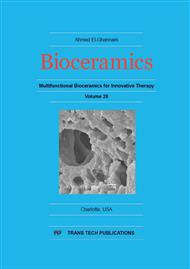p.193
p.197
p.203
p.207
p.210
p.215
p.219
p.223
p.228
Study of Morphological Behavior of Hydroxyapatite, EDTA Hydroxyapatite and Metal Doped EDTA Hydroxyapatite Synthesized by Chemical Co-Precipitation Method via Hydrothermal Route
Abstract:
Hydroxyapatite Ca10(PO4)6(OH)2: (HAp) with stoichiometric composition and Ca/P (ratio) = 1.67 has attracted much attention in the context of bone transplant due to its similarity with the mineral constituent of mammals bone and teeth. It is frequently used as a filler to replace amputated bone or as a coating to promote bone ingrowth into prosthetic implants. Biomimetics or biomimicry is the imitation of the models, systems, and elements of nature for the purpose of solving complex human problems. Living organisms have evolved well-adapted structures and materials over geological time through natural selection. Biomimetics has given rise to new technologies inspired by biological solutions at macro and nanoscales. Nanostructure modification of dental implants has long been sought as a means to improve osseointegration through enhanced biomimicry of host structures. Several methods have been proposed and demonstrated for creating nanotopographic features.In the present investigation hydroxyapatite and metals (scandium, magnesium and neodymium) doped hydroxyapatite were successfully synthesized in laboratory by chemical precipitation using hydrothermal route and also by taking ethylene diamine tetra-acetic acid as a complexing reagent. The crystal, grain, and bonding structures of resulting HAp were characterized structurally using X-ray diffraction (XRD) and scanning electron microscopy (SEM) techniques and spectroscopically using Fourier transform infrared (FT-IR) techniques. From SEM analysis it was found that the irregular structure of HAp changes to nanorods with EDTA HAp which further gets converted to dandelium structure with scandium doping, plate structure with magnesium doping and whiskers structure on doping with neodymium.
Info:
Periodical:
Pages:
210-214
Citation:
Online since:
November 2016
Keywords:
Price:
Сopyright:
© 2017 Trans Tech Publications Ltd. All Rights Reserved
Share:
Citation:


